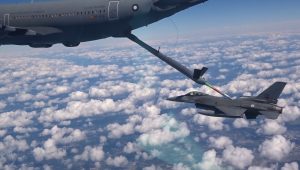2017-05-09 During an interview at the Amberley Air Base last month with Air Commodore Lennon and the 86th Wing Commander, Group Captain Adam Williams, we discussed the evolution of the KC-30A into Tanker 2.0.
One aspect of that evolution was the coming of the robotic boom.
According to Air Commodore Lennon: “The best way to think about the new boom capability is that it is an automatic boom similar to how autopilot works in the cockpit. The automatic pilot simplifies the pilot load, but the pilot is still there and can override the autopilot in case of need.
“There will always be an operator monitoring what’s going on with the boom, deciding what the boom should do, and when it should do it, but now he can let the boom do all the work of positioning and marrying up with the receiver.”
The KC-30A is a refuelable aircraft so with a fatigue reducing automatic boom, the crew can stay airborne for longer to generate additional operational impact and enhanced sortie generation effects.
Testing the Robotic Boom for the A330 MRTT from SldInfo.com on Vimeo.
Air Commodore Lennon saw other potential impacts on operations as well from having an automatic boom.
“If it can anticipate and react to movements of the receiver aircraft faster than the boom operator can, then you end up with faster contacts.
You also potentially end up with more consistent contacts when the turbulence level increases, in cloud or when night falls.”
A press release from Airbus Military on May 9, 2017 focused on a recent successful test of this new capability.
Madrid, 9 May 2017 – Airbus Defence and Space has successfully demonstrated automatic air-to-air refuelling (AAR) contacts with a fighter aircraft from a tanker’s refuelling boom – the first time in the world that this has been done.
Airbus’ A310 MRTT company development aircraft performed six automatic contacts with a F-16 of the Portuguese Air Force in a demonstration of a technique which the company believes holds great promise for enhancing in-service AAR operations.
The system requires no additional equipment on the receiver and is intended to reduce boom operator workload, improve safety, and optimise the rate of AAR in operational conditions to maximise combat efficiency.
It could be introduced on the current production A330 MRTT as soon as 2019.
Initial approach and tracking of the receiver is performed by the tanker’s Air Refuelling Operator (ARO) as usual.
“Innovative passive techniques such as image processing are then used to determine the receiver’s refuelling receptacle position and when the automated system is activated, a fully automated flight control system directs the boom towards the receiver’s receptacle.
“The telescopic beam inside the boom can be controlled in a range of ways including: manually by the ARO; a relative distance-keeping mode; or full auto-mode to perform the contact.
 In the 21 March flight off the Portuguese coast, the tanker performed the scheduled six contacts, at flight conditions of 270KT and 25,000ft over a 1hr 15min test period. Both crews reported a faultless operation.
In the 21 March flight off the Portuguese coast, the tanker performed the scheduled six contacts, at flight conditions of 270KT and 25,000ft over a 1hr 15min test period. Both crews reported a faultless operation.
David Piatti, Airbus Test ARO, or “boomer”, on the tanker, said: “The most important thing was that the system could track the receptacle. It was very satisfying because it worked perfectly and we could perform the contacts with the automation switched on as planned. It will certainly reduce workload, especially in degraded weather conditions.”
The F-16 pilot, known by his callsign “Prime”, said: “The test mission was pretty uneventful and accomplished with no unexpected issues – which is a good sign. From the moment that the boomer accepted the contact the boom was immediately in the correct spot. For the contact itself, it was very precise and expeditious. You can notice the difference – the less that you feel in the cockpit then the more precise you know the tracking is.”
Miguel Gasco, Head of Airbus Defence and Space’s Incubator Laboratory which coordinated the development, said: “This represents a fundamental advance in boom AAR operations, with the promise of increasing the rate of contacts, notably reducing operator workload, and enhancing safety. The automated boom operation is an important pillar of our Smart MRTT development that is already underway.”
The imaging technology underlying the Automatic AAR technique was originally used by Airbus’ Space division to develop solutions for refuelling satellites in space or for space debris removal and was further developed and applied by Airbus Defence and Space’s Incubator Laboratory for the tanking application.

